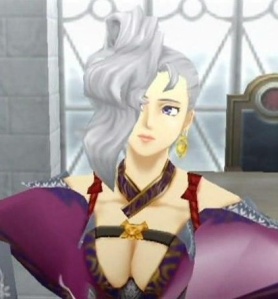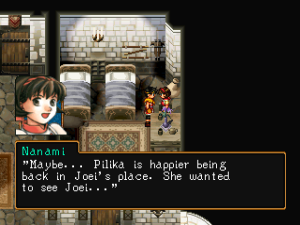Okay, this was totally supposed to be a review of Gone Home (made possible thanks to a new computer capable of running modern games), but nostalgia beats novelty. Especially when it comes to the Suikoden series, which is officially my favourite game series of all time.
Speaking of which? PLEASE KONAMI MAKE SUIKODEN VI. I WILL PAY ALL THE MONEYDOLLARS FOR IT.
Anyway, when I heard Konami was finally re-releasing Suikoden II on the Play Station Network–its long, depressing absence made all the crueler by the longstanding release of the original Suikoden on the same platform–I was happy I’d have a chance to replay it. Legally! With a copy I own (or, I guess, license from Sony…but let’s not pick nits). I was so delighted because, well, let’s get serious: pretty much the whole fanbase for this game was forced into piracy due to the game’s absurdly small production run and subsequent abandonment by Konami. Original copies cost literally hundreds of dollars. And no, great as Suikoden II is, it is not worth hundreds of dollars for someone’s scratched-up disc on eBay.
Despite my usual skepticism of re-releases as craven cash-grabs (how many times can I buy Chrono Trigger or FFIV, after all?), I think this is a hugely positive development for Suikoden II because of its prior unavailability and its potential to show the developers that yes there is a market for this series and please Konami make Suikoden VI because I will pay all the moneydollars for it.
Then again, Chrono Trigger DS didn’t exactly get us Chrono Break, did it?
With all that out of the way, it is time for me to be honest: I love Suikoden II deeply. Truly, I do. It deserves its reputation as one of the best JRPGs ever made. But it is not perfect. No, really, it isn’t. And, honestly, it may not even be my favourite Suikoden game.
Yeah, yeah, sacrilege and all that.
Here’s the thing. I played the Suikoden series out of order, starting with III and then working back through the first two. This is not something I recommend to other people coming to the series for the first time, for obvious but spoilery reasons (I seriously can’t imagine the oh shit moment that players of the first two games get have on that reveal, and I am the poorer for it). But I also think that starting with the third instalment of the series freed me from some of the expectations that pre-existing Suikoden fans must have had after playing the second game. In fact, I really appreciate a lot of the third game’s innovations and was sorry to see them disappear in the “back to basics” disaster they made in an attempt to appease the broken base. If I had to put the games in order of preference, which I am hesitant to do, I would put III slightly above a tie between II and V. Then there’s the first one, then several empty spaces, then IV.
But let’s keep discussion of the rest of the series for future replays and reviews (and my previous review of Tierkreis, if it counts). Instead, I’d just like to say a few things that came to mind during this replay of Suikoden II, and how I think it was totally worth blowing fifty hours on even though I have, like, shit to do.
[At this point, various spoilers for all games in the series. Be warned.]
First of all, the story remains a winner. None of the other games in the series, and really few other games ever, quite match up to Suiko II’s ability to intertwine the overarching political saga with the main character’s personal story, development, and motivations. V probably comes closest in this regard, and it often feels like there was a self-conscious effort on the part of V’s designers to return to II’s major plot elements and emotional beats (not to mention a whole lot of its cast). But even as Sialeeds serves a similar narrative function to Jowy (and acts for similar reasons), there is something about Riou and Jowy’s relationship that just doesn’t quite work as well when played out between a teenage aristocrat and his sexy spinster auntie.
As no shortage of recent reviews have also pointed out, the game still looks great, holding up even better than some of its comparatively high-budget contemporaries, whose fancy 3D graphics (for the time) just look plain bad. There is an important lesson here, and it is this: you can have a great-looking game with non-cutting-edge graphics. You can have a great-looking game with sprites. If that’s also cheaper to produce, then all the better. I’d rather play an excellent 2D JRPG with an innovative story and an appealing art style than even the most gorgeous over-produced decade-in-production Squeenix project.
Okay, so what are my gripes? Let’s go over them in order of increasing annoyance.
1) The localisation sucked then, and it sucks now. What could it possibly cost to fix that in the port? There is some seriously embarrassing shit there. I especially like how Futch and Humphrey take a seemingly uncharacteristic journey in the end credits to see the Crystal Ballet (that’s Crystal Valley, in Harmonia).
2) I’ll say it. I kind of don’t like Pilika. I think her character is rather crassly manipulative for what is an otherwise emotionally balanced and sophisticated game. I think the game would be stronger without her, especially if they found other more subtle ways to reassure us of Jowy’s goodness despite his treacherous actions.
3) Some of the dungeons are just too long. Or at least too long to remain interesting. Because of the (awesome) EXP system, there is no reason to grind random encounters except for money (which is usually not a big problem anyway). The limited art style also means that dungeons don’t have anything to keep you visually interested for very long, as you can only arrange the chunks so many ways. Worse yet, you have to return to two of the worst offenders again to recruit stars. The final dungeon is so long you can actually max out your money just from random encounters before you’re halfway through it. Totally unnecessary, and definitely broke up the excitement of the narrative.
4) The castle is, like, legit confusing. I could never remember where anything was, and the elevator didn’t take you to any of the places you actually needed to go. Viki, your shops, and your change-party person should always be within one screen from the elevator. Anything else is stupid and wastes time. It took me ages to figure out how to reliably get to the restaurant, especially since it mysteriously changes once during a castle upgrade. (Aside: this was my first time doing the whole Iron Chef subquest, and man am I bummed about Shun Min’s fate, since we meet her in V).
5) The strategy battles are so scripted as to be mostly pointless, and it doesn’t appear that your characters’ actual stats have any effect on their war units. The only time you do actually fight a whole battle, it’s basically impossible to put together a unit with a high enough attack value to take down the major enemies. Talk about ludo-narrative dissonance. Here I have Georg Prime at level 60, leading a unit with strategic genius and a total tank, and their combined attack is still 12? I think III handled this problem the best, with war battles played out as limited-control versions of regular combat. That way your characters’ strength actually mattered to your army in a very real sense, and it was plainly visible in combat.
6) The best ending isn’t the best ending. Or rather, it is not the most dramatically effective or believable ending. It just rings false. Granted, the design of the game is such that it is not intended to be the first ending you see. The designers planned for the players to have to work for that wish-fulfilment: the possibility that everything really could be “happily ever after” and “off into the sunset.” Sure, I can choose not to save Nanami and Jowy, but, as with the knowledge that it is possible to save Cid in FFVI, I just end up feeling bad if I don’t do it. Because not acting on this knowledge means I am consciously choosing their deaths. I also usually keep Ridley in my play-throughs of Suiko II, even though the Tinto escape sequence is clearly dramatically superior to the alternative. Because I like Ridley. Why should he have to die if I can avoid it?
I think this problem, something I’ll call the “Cid Paradox,” is an interesting and important problem for games and game designers. Giving players the ability to affect in-game events and outcomes is baked right into the medium, but sometimes allowing them to make certain choices, particularly when these result in saving characters from otherwise certain death, can have the unintended consequence of making them feel obliged to follow the “correct” or “complete” or “canon” version. Because in the complete version, everyone who can survive, does.
So let’s think for a minute about some cases where you don’t get the choice. Right in Suiko II we have General Kiba, who leads a suicide mission to distract the enemy right before the events at Rockaxe that lead to Nanami’s (pseudo-) death. Kiba’s sacrifice is real and moving. But I would probably save him if I could. Ditto for Mathiu in the first game. Sometimes people say that Aerith’s death in FFVII was when gaemz got real, yo, because you couldn’t get her back. But we still spent millions of collective player-hours trying to do it, back in the days when your friend’s cousin totally did it and here’s how.
At this point the 108 star wish-fulfilment ending seems like an essential part of the Suikoden series. Four out of the five main games do it, after all. But the one exception to the rule was such an astonishing bit of game design that I honestly wish that they’d struck upon the idea just a little earlier. In Suikoden III (yes I like III best, get over it), getting all the stars doesn’t save anyone at all. Instead, it unlocks an entirely new section of the game, playable from the point of view of the main antagonist. It shows his actions behind the scenes, adds additional depth to his character motivations, and fleshes out just a little more of the Big Plot of the Suikoden world, the one that we’ll unfortunately probably never see resolved (PLEASE KONAMI WRAP IT UP IN SUIKODEN VI).
Now tell me you wouldn’t trade all the happy endings in the world to to see Jowy’s adventures in Highland.




Love JRPGS!